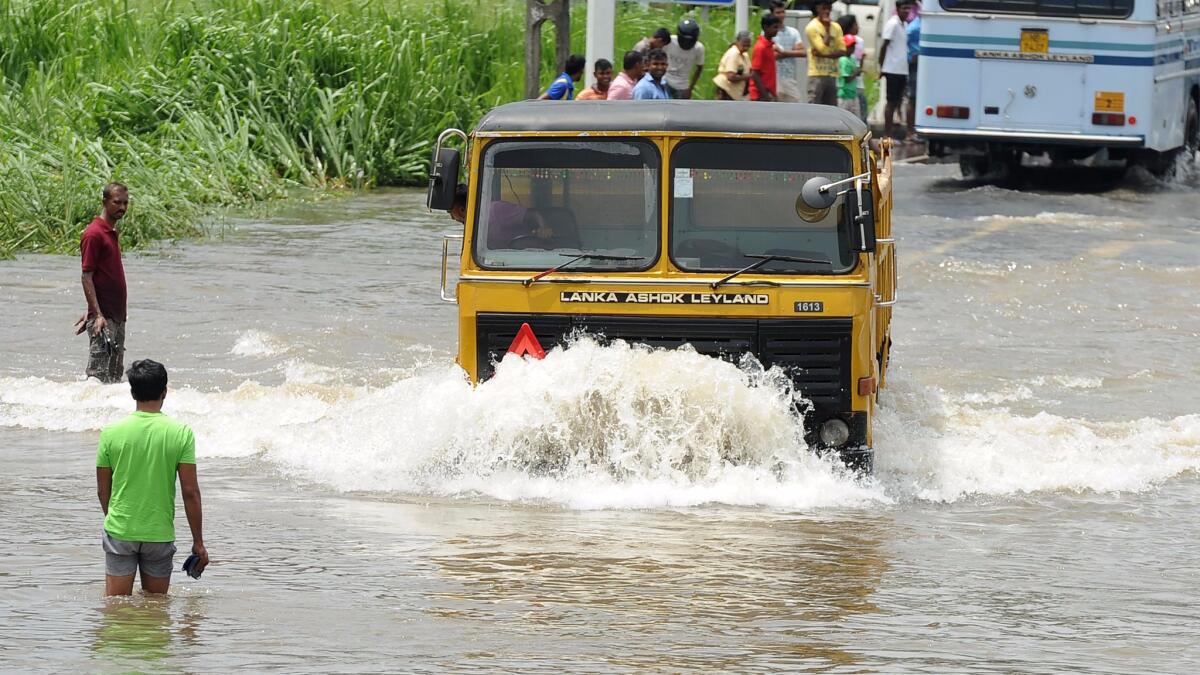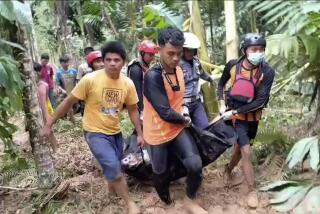Terror of Sri Lankan landslides: ‘All I could do was scream’
Soldiers and police on Thursday struggled to find hundreds of people missing after landslides destroyed at least three central Sri Lankan villages, with fresh rains triggering smaller slides and forcing rescuers to briefly suspend their efforts.
Torrents of water streamed down the hill where mountains of mud swallowed three villages — Siripura, Elangapitiya and Pallebage — on Tuesday evening, and the continuing danger forced rescue work to halt for about an hour. So far, 18 bodies have been recovered from the mud. The Sri Lankan Red Cross said at least 220 families were unaccounted for.
Heavy fog, electrical outages and the loose ground also have complicated the search.
Asked whether rescuers expected to find survivors, army Maj. Gen. Sudantha Ranasinghe pointed to an area in Elangapitiya village where 66 houses once stood.
“We don’t have a trace of any house here. All gone with that landslide,” he said. “So I have my doubts.”

Villagers said torrents of muddy water, tree branches and debris came crashing down Tuesday around their homes in the three villages in Kegalle district, about 72 kilometers (45 miles) north of Colombo.
Near Elangapitiya, the village furthest down the hill, soldiers carried bodies to a school where families waited for news of missing loved ones. The school entrance was decorated with white flags, a symbol of mourning.
Farmer Hewapelige Lal said he had identified the body of his nephew, but that 18 other family members were possibly buried under the mud. He and his wife had left their home to take fruit to a daughter who lived elsewhere, but at some point his wife turned back.
“That was the last time I saw her,” Lal said, sobbing. When he heard of the landslide, he rushed home but found the area covered with thick, heavy mud. “All I could do was scream.”
In Elangapitiya alone, 14 bodies were recovered Wednesday and about 130 people were still missing, according to Maj. Gen. Sudantha Ranasinghe, who was coordinating rescue efforts. The Red Cross said some of those missing may have left before the disaster; heavy rains have lashed the island nation for several days, and local officials had warned residents of possible landslides.
See more of our top stories on Facebook >>
Hundreds of stunned villagers took shelter in nine temporary camps set up in schools and a Buddhist temple, where they were being given food, blankets and basic medical treatment.
At the Viyaneliya Temple, about 300 villagers shared a meal of brown bread and curried lentils. Local officials interviewed each one to learn about missing family members and possessions buried under the mud.
All nine of A.G. Alice’s children were unaccounted for after the landslide hit their home in Siripura village.
I still can’t locate my family. I still don’t know what happened to them.
— M.W. Dharmadasa
“I don’t know what happened to me” after the landslides swept down, the 70-year-old said.
A man said his wife, mother-in-law, son and daughter-in-law were all in his house in Siripura when the landslides hit. “I still can’t locate my family,” M.W. Dharmadasa said. “I still don’t know what happened to them.”
Military spokesman Brigadier Jayanath Jayaweera told reporters in the capital, Colombo, that the army had so far rescued 156 people trapped by landslides, and that more than 1,550 people are in shelters. He said the army was assessing the situation and would deploy more troops if needed.
The same rains that unleashed the mudslides also caused severe flooding in cities including Colombo, the capital, where tens of thousands of homes were at least partially inundated.
Sri Lanka’s disaster management center reported 41 deaths across the country since Monday from lightning strikes, floods, falling trees and other, smaller landslides. Nearly 135,000 people have been displaced and are in temporary shelters.
Mudslides are common during the monsoon season. Much of Sri Lanka has been deforested to clear land for agriculture, leaving the countryside exposed.
During heavy rains in December 2014, authorities evacuated more than 60,000 people from thousands of homes damaged or destroyed by floods or landslides. Two months before that, dozens of tea plantation workers were killed when mudslides buried their hillside homes.
ALSO
World powers call for ‘air bridge’ to get humanitarian supplies into Syria
An ethnically charged dispute over electricity brings protesters into Kabul’s streets
A grandfather’s grief on the bloodiest day Baghdad has seen in months
More to Read
Start your day right
Sign up for Essential California for news, features and recommendations from the L.A. Times and beyond in your inbox six days a week.
You may occasionally receive promotional content from the Los Angeles Times.






